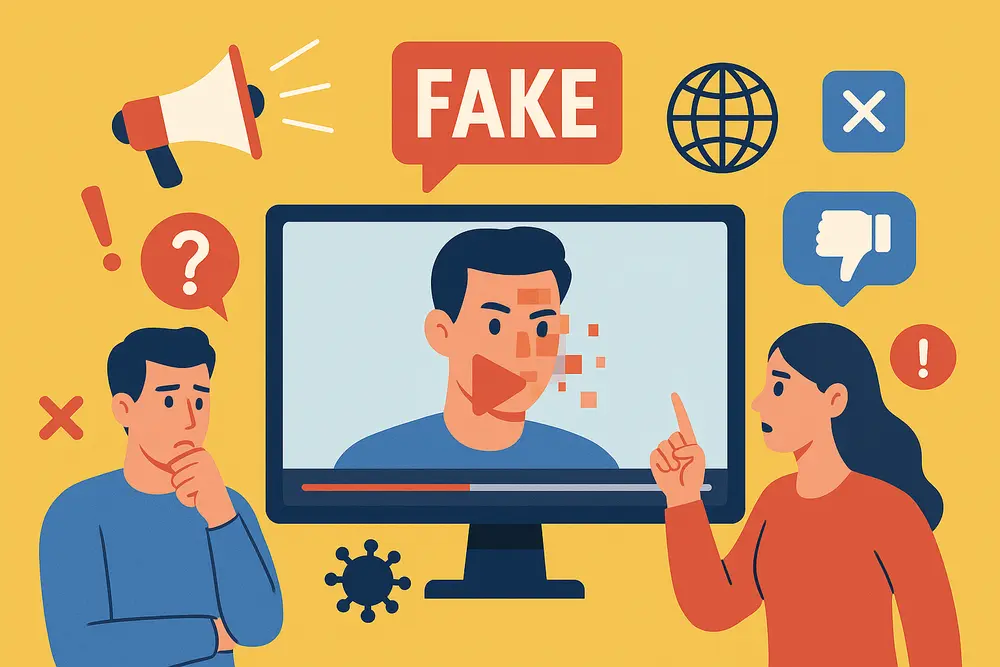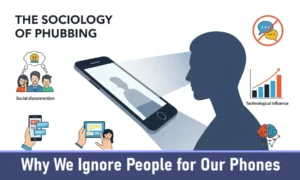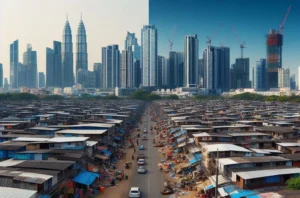In today’s scroll-happy world, videos feel like the ultimate proof—quick, punchy, and impossible to ignore. But here’s the twist: not everything that looks real is real.
Fake videos have quietly become one of the most powerful drivers of misinformation, slipping into our feeds disguised as truth and steering public opinion without us even noticing.
A cleverly clipped moment or an AI-crafted face can spark outrage, fuel rumors, and deepen divides in seconds. And because our brains are wired to trust visuals, these digital illusions hit hard and spread fast.
In this article, we will break down how fake videos work, why we fall for them, and how they subtly shape what we believe. Let’s decode the deception—frame by frame.

How Fake Videos Fuel Misinformation and Shape Biased Public Opinion: Decoded
Fake videos have grown into one of the most alarming byproducts of the digital age. With smartphones in every hand and editing tools becoming both accessible and sophisticated, anyone can create or manipulate a video that looks undeniably real.
In this chaotic information environment, it becomes crucial to distinguish misinformation—false content shared unknowingly—from disinformation, which is crafted and spread with deliberate intent to deceive.
What makes videos particularly dangerous is their inherent credibility. People trust what they can see; visuals bypass skepticism and trigger emotions far faster than written text ever can.
A cleverly edited clip can spark outrage, fear, or blind belief within seconds, long before the truth has a chance to catch up.
Let’s argue that fake videos do far more than spread lies—they actively reshape public perception, reinforce existing prejudices and erode the foundation of societal trust.
As these deceptive visuals multiply, the challenge is no longer just identifying the truth, but protecting how we collectively understand reality itself.
The Psychology Behind Trusting Videos
Humans have an instinctive habit of trusting what they see. The old saying “seeing is believing” still shapes how our brains process information, even in a world where videos can be fabricated with a few clicks.
Visuals feel concrete and undeniable; they demand less mental effort to evaluate than text, which is why videos often slip past our internal filters of doubt. But beneath this trust lie powerful cognitive biases.
Confirmation bias pushes people to accept videos that match their existing beliefs, no matter how unrealistic they may be.
Availability heuristic makes shocking or emotional videos feel more common or representative than they actually are—if a disturbing clip goes viral, viewers assume similar events happen everywhere.
And then there’s emotion-driven decision-making: when a video triggers anger, fear, or sympathy, rational analysis shuts down, allowing reactions to overpower reasoning.
Fake videos are crafted to exploit these shortcuts. They are designed to mimic authenticity, evoke strong emotions, and align with preexisting narratives, making viewers far more vulnerable to manipulation.
Ultimately, the psychology behind trusting videos becomes the very tool used to deceive us, turning our natural perception mechanisms into gateways for misinformation.
Types of Fake Videos
Fake videos appear in many forms, each using different techniques to distort reality. From AI-generated faces to harmless-looking clipped footage, these manipulations can easily mislead viewers.
Understanding the major types is essential for recognizing digital deception and preventing misinformation.
Deepfakes
Deepfakes use advanced AI to swap faces, mimic voices, or recreate expressions with astonishing accuracy.
Powered by deep learning, these videos can make someone appear to say or do something they never did.
While deepfakes are sometimes used for entertainment or art, they are increasingly misused to fabricate scandals or impersonate individuals in dangerous ways. Their realism makes them one of the most alarming forms of fake content because viewers struggle to distinguish them from genuine footage.
Shallow Fakes
Shallow fakes rely on simple editing tricks rather than advanced AI. These include trimming a video to remove context, slowing or speeding frames, altering audio, or presenting a harmless clip in a misleading way.
Despite their simplicity, shallow fakes often spread faster than deepfakes because they look believable and require minimal technical skill to produce. They are especially dangerous because people rarely question subtle edits that seem plausible at first glance.
Completely Fabricated CGI Videos
Fabricated CGI videos are created entirely through computer-generated imagery, with no real footage involved.
Modern CGI can produce lifelike humans, animals, disasters, or events that never occurred. Because they appear polished and cinematic, viewers may interpret them as real recordings, especially when shared without context.
CGI fake videos often go viral due to their dramatic visuals—like fictional creature sightings or fake natural disasters—demonstrating how realism in animation can easily blur the line between imagination and truth.
Old Videos Shared as New Events
Sometimes, a video isn’t edited at all—it’s simply taken out of its original time or place and presented as a recent incident. This recontextualization can spark confusion or panic, especially during emergencies or social unrest.
Old footage of accidents, natural disasters, or crowd incidents is frequently reshared with misleading captions claiming it happened “today.”
Because the content is technically real, viewers rarely question its authenticity, making this one of the most effective misinformation tactics.
Read Here: How Deepfake Is Eroding Social Trust in Digital Age
How Fake Videos Spread Misinformation
Fake videos spread misinformation at a speed that outpaces fact-checkers, largely because of how social media platforms are designed.
Algorithms reward content that generates high engagement—likes, shares, comments, watch time—regardless of whether it is true.
A fake video that shocks or outrages viewers is far more likely to be pushed to the top of timelines than a calm, factual explanation. This creates a perfect environment where manipulated visuals can explode in popularity within minutes.
Influencers, bots, and coordinated networks accelerate this spread even further. Influencers—knowingly or unknowingly—share dramatic clips to maintain engagement with their audiences.
Meanwhile, bots and fake accounts amplify these posts by liking and resharing them at scale, making the content appear more credible and widespread.
When multiple coordinated accounts push the same video, it creates an illusion of legitimacy, convincing viewers that “everyone is talking about it.”
Emotional triggers play a central role in this chain reaction. Fake videos are often designed to provoke fear, anger, or shock—emotions that override logical thinking and push people to share impulsively.
A disturbing clip taps into primal instincts, making viewers feel responsible for “warning others.”
History offers several examples of how a single misleading video created chaos. A morphed animal-attack video once caused mass panic in rural areas, while an edited clip showing a bridge collapse sparked unnecessary evacuations.
In each case, the video spread faster than corrections could reach the public. This demonstrates how one deceptive visual, amplified through digital pathways, can escalate into real-world confusion and fear.
Read Here: Effects of Social Media Misinformation on Indian Elections
Impact of Fake Videos on Public Opinion
Fake videos don’t just spread falsehoods—they reshape how people perceive the world. By manipulating emotions and exploiting existing beliefs, they quietly shift public opinion. Their influence can be seen in distorted realities, widening social divides, and growing mistrust in institutions and authentic information sources.
Distortion of Reality
Manipulated videos create an alternate version of events that feels completely real to viewers.
When people repeatedly encounter such visuals, they begin forming opinions based on illusions rather than facts. Over time, these fabricated moments blend into public memory, making false narratives appear ordinary and widely accepted.
This distortion becomes especially powerful when the fake content aligns with fears or assumptions people already hold, allowing misinformation to seep into everyday discussions and influence collective understanding of real-world issues.
Polarization and Bias Reinforcement
Fake videos often target emotional sensitivities and ideological identities, deepening divides between groups.
When a manipulated clip supports someone’s beliefs, confirmation bias kicks in, making them more likely to trust it without question. This reinforces echo chambers and hardens viewpoints, leaving individuals less open to opposing perspectives or factual corrections.
As people retreat further into their ideological corners, fake videos serve as fuel, intensifying polarization and making honest dialogue increasingly difficult in society.
Loss of Trust in Media and Institutions
As fake videos become more convincing, people start doubting everything—even authentic recordings. This phenomenon, known as the “liar’s dividend,” allows individuals and institutions to dismiss genuine evidence by claiming it’s fake.
The resulting uncertainty erodes trust in journalism, official agencies, and public figures. In this environment, politicians or organizations can manipulate narratives more easily, knowing that citizens feel unsure about what to believe.
The long-term effect is a weakened information ecosystem and widespread skepticism toward truth itself.
Social, Political and Economic Consequences
Fake videos have consequences that ripple far beyond the digital screen, shaping societies, politics, and economies in often destructive ways.
In the political arena, manipulated videos can influence elections by smearing candidates, spreading false promises, or igniting outrage among voters. Such content can push individuals toward extreme ideologies, fueling polarization and radicalization.
Socially, a single misleading video can trigger communal tensions or large-scale unrest, especially when it targets sensitive cultural or religious sentiments. These clips spread faster than clarifications, allowing fear and anger to escalate before authorities can respond.
Economically, businesses are increasingly vulnerable to staged or deceptively edited viral videos.
A fake clip showing contaminated food, poor service, or unethical practices can destroy a company’s reputation within hours—long before the truth is verified.
Many brands have suffered financial losses simply because viewers believed a manipulated recording.
The psychological fallout is equally serious. Constant exposure to fake videos creates a cycle of fear, confusion, and mistrust.
Viewers begin doubting everything they see, unsure whether any clip is real. This erodes their confidence not only in the media but also in institutions, authorities, and even their own judgment. Over time, such uncertainty can fracture social harmony and weaken democratic processes.
Detection and Verification Challenges
Detecting fake videos is becoming increasingly difficult because the technology used to create them is advancing faster than the tools designed to expose them.
Modern deepfake generators can replicate facial expressions, lighting, and voice patterns so accurately that even experts struggle to identify manipulation without specialized equipment. This creates a widening gap between the sophistication of fake content and our ability to verify authenticity.
AI detection tools, though helpful, come with their own limitations. Many tools work only on specific types of manipulations and often fail when creators use new techniques or combine multiple editing methods.
Some systems also produce false positives, mislabeling real videos as fake, which further complicates trust in automated verification.
Adding to the challenge is the general public’s limited digital literacy. Most viewers do not possess the skills to analyze metadata, identify inconsistencies, or question visual authenticity. As a result, they become easy targets for misinformation campaigns.
Content moderation at scale presents another major hurdle. Social media platforms handle billions of uploads daily, making it nearly impossible for human moderators or automated filters to catch every manipulated video.
Even when harmful videos are eventually flagged, they often spread widely before removal, rendering the corrections ineffective.
Key Strategies to Counter Fake Video Misinformation
Countering fake videos requires more than just identifying them—it demands a combination of technology, regulation, and informed public behavior. Effective solutions must strengthen verification systems, hold platforms accountable, and empower viewers with the knowledge to recognize manipulation before it spreads.
Technological Solutions
Technological defenses focus on identifying and authenticating content before it misleads viewers.
AI-based detection tools analyze facial patterns, audio inconsistencies, and pixel anomalies to flag manipulated videos.
Blockchain verification helps track a video’s origin and ensures tamper-proof authenticity. Additionally, watermarking genuine content—especially by news agencies and creators—creates a trusted visual signature that makes it harder for fake versions to circulate unnoticed.
Policy & Platform Accountability
Stronger policies are essential to curb the spread of manipulated videos. Platforms must enforce stricter rules for altered content, ensuring quick removal or clear labeling.
Transparent systems that flag edited or AI-generated videos can help viewers understand context.
At the regulatory level, governments should develop frameworks that combat misinformation without restricting free expression, balancing safety with fundamental rights.
Public Education
Empowering viewers remains one of the most effective defenses. Digital literacy programs teach people how to question sources, recognize manipulation, and verify authenticity before sharing.
Encouraging habits like checking multiple sources, pausing before reacting emotionally, and understanding how algorithms shape content consumption helps build a more resilient and critically aware society capable of resisting misinformation.
Conclusion
Fake videos have become one of the most potent threats in today’s information landscape, blurring the line between truth and illusion. Their ability to manipulate emotions, distort events, and silently shape public opinion makes them more dangerous than traditional misinformation.
As technology continues to evolve, the challenge will only intensify, demanding vigilance and adaptability from society.
Addressing this issue requires a multi-layered approach. Advanced detection tools must keep pace with emerging manipulation techniques, while thoughtful policies and platform regulations ensure accountability without stifling freedom of expression.
Equally important is cultivating public awareness—teaching individuals how to question, verify, and interpret digital content with a critical eye.
Ultimately, the responsibility doesn’t rest on institutions alone. Every viewer plays a role in slowing the spread of falsehoods.
By pausing before sharing, seeking credible sources, and staying informed about digital manipulation tactics, people can become empowered digital citizens.
The path to a healthier information ecosystem begins with collective responsibility and a commitment to safeguarding the truth.





